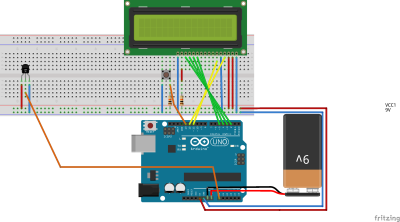#include <LiquidCrystal.h>
// Décl des pins
const int sensorPin = A0;
const int switchPin = 13 ;
int previousTmpSensorVal = 0 ;
float voltage = 0.0;
float temperatureC = 0.0;
int switchState = 0 ;
// Constantes du LCD
const int rs = 12, en = 11, d4 = 5, d5 = 4, d6 = 3, d7 = 2;
LiquidCrystal lcd(rs, en, d4, d5, d6, d7);
void setup() {
pinMode(13, INPUT);
lcd.begin(16,2);
lcd.print("Affichage");
lcd.setCursor(0,1);
lcd.print("Temperature");
delay(1000);
// Reinitialisation LCD
lcd.clear();
}
void loop()
{
// Lecture de la valeur du capteur
int tmpSensorVal = analogRead(sensorPin);
// Lecture de l'interrupteur
switchState = digitalRead(switchPin);
lcd.setCursor(15,1);
lcd.print(switchState);
// Valeurx Fixes du LCD
lcd.setCursor(8,0);
lcd.print("V:");
lcd.setCursor(0,1);
lcd.print("Temp.:");
lcd.setCursor(12,1);
lcd.print("C");
// Si changement capteur, on (re)calcule la temperature
if (tmpSensorVal != previousTmpSensorVal ) {
// Calcul du volatge et conversion en degré Celsius
voltage = tmpSensorVal * 5.0;
voltage /= 1024.0;
temperatureC = (voltage - 0.5) * 100 ;
previousTmpSensorVal = tmpSensorVal ;
}
// Affichage sur demande (appui switch)
if (switchState == 1) {
// Affichage LCD
lcd.display();
lcd.setCursor(0,0);
lcd.print(tmpSensorVal);
lcd.setCursor(10,0);
lcd.print(voltage);
lcd.setCursor(7,1);
lcd.print(temperatureC);
delay(10000);
} else { // On éteint le LCD
lcd.noDisplay();
}
delay(500);
}
